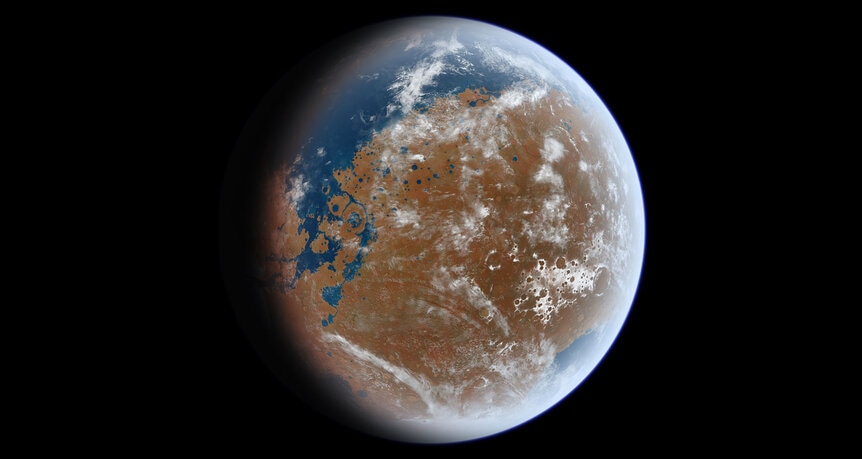Create a free profile to get unlimited access to exclusive videos, sweepstakes, and more!
More liquid water found on — *under* — Mars!

In 2018, planetary scientists made an astonishing claim: They had found a large lake of liquid water under the surface of Mars near the Martian south pole.
The evidence was pretty striking, but not quite 100% convincing.
In a new paper, the same team of scientists announce that they have collected more data, reanalyzed what they had before, and not only do they say it strengthens their earlier claim, but they have also found three more lakes under the frozen Martian surface!
So, yeah, this is very exciting.
The data come from the Mars Advanced Radar for Subsurface and Ionosphere Sounding (MARSIS), an instrument about the ESA's Mars Express spacecraft, which has been orbiting the red planet since late 2003. It sends pulses of radar to the planet below, which reflects them back up. Different materials reflect the radar with different efficiencies, so that scientists can get an idea of the kinds of stuff on the surface.
But, these pulses can also penetrate fairly deeply into the ground before being reflected, and that allows scientists to literally get a picture of material below the surface.
The 2018 result was for a region called Ultimi Scopuli, several hundred kilometers from the south pole of Mars in an area of South Polar Layered Deposits, a huge bed of nearly pure water ice that stretches for over a thousand kilometers. They found that about 1.5 kilometers below the surface were radar reflections consistent with liquid water.
Coincidentally, around that same time, a different group of scientists used a similar technique to find subglacial water in the Canadian ice cap. The Mars scientists saw this, and realized they could adapt this technique to the MARSIS data. They got more observations from the venerable orbiter, and processed not just their new data but the old set as well using the new technique.
Not only did they see the original lake better — and measure its size as 30 x 20 km, so decently big — but they also found at least three more lakes several kilometers across.
That's amazing. And puzzling. The temperature in that region is likely colder than -100° C. Pure water would be frozen harder than rock at that temperature! So how can it be liquid?
The scientists postulate that the water is extremely salty. A chemical called perchlorate is present all over Mars in the surface regolith (the grains from eroded rocks). This is a salt, and if it got into melted water in sufficient quantities the hypersalinity could keep the water from freezing (the same reason we throw salt on sidewalk and road ice in the winter, to lower the melting point so it can melt into a liquid). It's possible that geothermal warmth melted the base of the SPLD base a long time ago, and the perchlorates have kept it from refreezing ever since.
This is pretty exciting news. We know Mars had lots of liquid water* on its surface billions of years ago — there are vast riverbeds, tributaries, dry lakes, and even evidence of ocean shorelines all over the planet — and likely a thicker atmosphere as well. Mars is smaller than Earth, and farther from the Sun, so it would have cooled more quickly after it formed. While Earth was still a harsh world, Mars may have looked more like Earth does now than the Earth did at the time.
It is therefore not ridiculous to wonder if Mars developed life. Certainly, I'd bet a decent amount of cash that any alleged life on the surface is long dead. But life, uh, finds a way, and as the atmosphere of Mars leaked away, sandblasted by eons of solar wind, and the water dried up or froze or retreated underground, life could have adapted. Life is very good at that; it does that here on Earth, where we find extremophiles (life that loves extreme conditions) in very unlikely locations, including hypersaline lakes.
Looking for evidence of fossil life on the surface of Mars is a good idea, even if it's microbial. But if there are such lakes of liquid water under the surface, then it may be an even better idea to look there for extant life. I'll admit it seems unlikely, even a long shot, but worth investigating. Drilling down into the superchilled ice of the SPLD won't be easy either, of course. But the payoff could be very, very big.
*A recent study showed that Mars may have been covered in ice back then. It still would have had liquid water at the glaciers' bases, though, and it's not clear if the ice age happened after a lengthy warm, wet period.





























